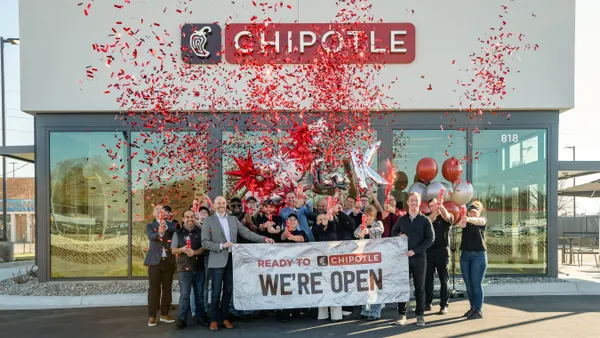Dive Brief:
- The quick-service segment will grow at a CAGR of 4.6% from now through 2022, largely due to evolving lifestyles, new infrastructure and burgeoning demand for fast food in developing countries, according to market research by Technavio. The report followed brands such as Chick-fil-A, Domino’s, Subway, Wendy’s and Dunkin'. In addition to modernizing the eat-in experience, the segment also is expected to further invest in drive-thru, take-out and home-delivery services over the next four years.
- U.S. and Canada lead the quick-service market, but Asia will grow the fastest as cities expand along with consumer awareness of ready-to-eat meals. Global chains have likewise focused growth in China, where 1.38 billion people live, and India, whose population will surpass 1.4 billion by 2022.
- Despite the likelihood of expansion, researchers warn that volatile raw material costs and stricter government policies, particularly against packaging, could dampen growth.
Dive Insight:
While the U.S. restaurant landscape has been inundated by fast casual concepts in recent years, established fast food brands have eyed growth in international markets, especially in Asia and now in Latin America. Technavio studied Yum Brands, for instance, whose largest chains — KFC and Pizza Hut — pioneered Chinese expansion in the late 1980s. Today, about 77% of KFC’s nearly 20,000 stores are outside the U.S., and Pizza Hut’s international count has nearly caught up with the U.S. McDonald’s international reach exceeds 21,000 units, compared to about 14,000 domestically.
These chains have all found receptive customers abroad. Some might be eager to try American favorites like the Big Mac, while others opt for items created with local cuisine in mind, such as a prawn-topped Pizza Hut pie in Australia. No longer isolated, the world’s cultures have blended together, and U.S. chains have capitalized on growing middle classes in booming economies such as Japan and China.
Restaurants will gain more than 7% in CAGR in China by 2023, according to Mordor Intelligence, driven by a similar demand for exotic foods, unique experiences and online ordering. Though KFC alone controls 11% of the chain-restaurant market in China, sales for the chicken chain, Pizza Hut and McDonald’s have all dropped in the past couple of years.
Some of that slowdown likely stems from the growth of non-U.S. chains, many of which have originated in the same developing economies. Sixteen of Nation’s Restaurant News International Top 25 chains call Southeast Asia home, 12 of which are in Japan. Jollibee, the Filipino fried chicken chain, enjoyed 14% sales growth from 2016 to 2017 and, after expanding throughout Asia and the Middle East, recently announced major expansion plans in the U.S. and Canada.
Consumers around the world have developed sophisticated palates that crave not just regional delights, but also classic American flavors. In the fast casual segment, upstarts like MOD and Blaze Pizza battle for the top spot of fastest-growing chain. Meanwhile, four of the 10 fastest growing U.S. chains serve chicken. In the coffee segment, Starbucks still dominates, but Dunkin’ and the U.K.’s Costa Coffee have tapped into global demand for coffee on-the-go and the bakery snacks that come along with it.
Quick-service isn't expected to grow as much as fast casual and limited-service restaurants, which will jump 7.5% this year, according to Techonomic, though casual dining has suffered the most from these shifts in consumer tastes and convenience.










